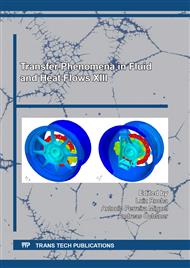p.115
p.131
p.141
p.149
p.163
p.177
p.185
p.197
p.207
Elaboration and Characterization of Cu Based Nanocomposites for Electromagnetic Interferences Shielding
Abstract:
An electromagnetic interferences (EMI) shielding is a material that attenuates radiated electromagnetic energy. Polymer nanocomposites is a class of materials that combine electrical, thermal, dielectric, magnetic and/ or mechanical properties, which are useful for the suppression of electromagnetic interferences. In this work, we looked over the effectiveness of the electromagnetic interferences shielding of polymer-based nanocomposites. These are thin samples of epoxy resin strengthened with nanostructured Cu powders. Nanostructured Cu powders were obtained by mechanical milling using the high-energy RETSCH PM400 ball mill (200 rpm). A powder sampling was conducted after 3h, 6h, 12h, 24h, 33h, 46h and 58h milling for characterization requirements. XRD analysis via the Williamson-Hall method shows that the mean crystallites size decreases from 151.6 nm (pure Cu phase) to 13.8 nm (58 h milling). Simultaneously, the lattice strain increases from 0.1% (pure Cu phase) to 0.59% (58 h milling). The elaboration of thin samples was performed by mixing a vol./3 fractions of nanostructured Cu powder, epoxy resin and hardener. Thin slabs of 1 mm thickness were moulded for use in a rectangular wave-guide. The EMI shielding experimental involved a two ports S parameters cell measurement made of R120 metallic wave-guides of rectangular section (19.05x9.525 mm2) and operational over the frequency band of 9.84 to 15 GHz associated to a network analyser. Obtained results show moderate EMI shielding effectiveness for the milled Cu-based slabs.
Info:
Periodical:
Pages:
177-184
Citation:
Online since:
November 2021
Authors:
Price:
Сopyright:
© 2021 Trans Tech Publications Ltd. All Rights Reserved
Share:
Citation:


